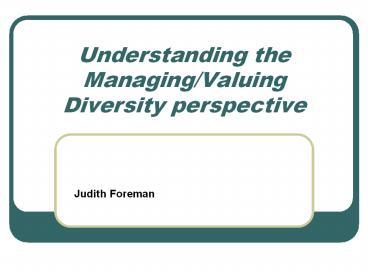Understanding the Managing/Valuing Diversity perspective - PowerPoint PPT Presentation
1 / 17
Title:
Understanding the Managing/Valuing Diversity perspective
Description:
Understanding the Managing/Valuing Diversity perspective Judith Foreman What is managing diversity ? The concept of Managing Diversity embodies two key ... – PowerPoint PPT presentation
Number of Views:45
Avg rating:3.0/5.0
Title: Understanding the Managing/Valuing Diversity perspective
1
Understanding the Managing/Valuing Diversity
perspective
- Judith Foreman
2
What is managing diversity?
- The concept of Managing Diversity embodies two
key assumptions - The heterogeneity and diversity of social groups
- discrimination and disadvantage are, therefore,
multifaceted - Organisations can benefit from valuing difference
and managing diversity effectively - Both ideas have implications for organisational
change and professional practice
3
What is Managing Diversity?
- MD is often defined by comparing it with Equal
Opportunities approaches - Some authors claim that MD represents a
paradigm shift in equal opportunities work - Some see MD as an extension/development of EOP
4
Equal Opportunities and Managing Diversity
compared drivers for change
- Equal Opportunities
- Externally driven
- Rests on moral and legal arguments
- Perceives EO as a cost
- Managing Diversity
- Internally driven
- Rests on business case
- Perceives MD (Managing Diversity) as investment
5
Equal Opportunities and Managing Diversity
compared degree of integration
- Equal Opportunities
- Operational
- Concerned with process
- Externally imposed low buy-in
- Managing Diversity
- Strategic
- Concerned with outcomes
- Internalised by all
6
Equal Opportunities and Managing Diversity
compared perception of difference
- Equal Opportunities
- Difference perceived as other/problematical
- Deficit model
- Assimilation advocated
- Managing Diversity
- Difference perceived as asset/richness
- Celebrates difference
- Mainstream adaptation advocated
7
Equal Opportunities and Managing Diversity
compared focus of action
- Equal Opportunities
- Focus on group discrimination
- Group initiatives
- Supported by narrow positivist knowledge base
- Managing Diversity
- Focus on development for all individuals
- Universal initiatives
- Individual development
- Supported by wider pluralistic knowledge base
8
Different approaches to WP emerging from research
9
Origins and application of MD to widening
participation in HE
- Private sector
- More recent application to public/not for profit
sector - Employment
- Generally not as well developed in relation to
customer/client diversity especially student
diversity
10
Business Case in HE
- Business case not an approach used in HE
- WP driven by a range of factors
- Govt policy
- Funding
- Institutional mission social justice
- Market position
11
Why a Business Case?
- Creates internal arguments for student diversity
and WP based on benefits to institution - HE Sector is partially marketised, so
business arguments apply - HE sector is diverse, so not one size fits all
- Organisational change
12
Elements of a Business Case
- Potential benefits to the institution
- Potential costs, risks and barriers
- Differential impacts on different stakeholders
- Do the benefits outweigh the costs?
- Can the costs be met?
13
External Drivers
Internal Drivers
Recruitment Pool of Talent Improving TL New
markets Reputation (Access to funding)
Legislation Funding and policy drivers Ethical
drivers - Social justice
Organisational Change
Mission Commitment Corporate Social Responsibility
14
Potential benefits to institutions
- Increased student numbers
- Tapping the pool of talent
- Improving teaching and learning
- Access to funding
- New roles and markets
- Complying with legislation
- Reputation
15
Group discussion activity
- Which of the benefits would be most relevant to
your institution(s)? - How might these provide a rationale for further
investment in managing student diversity? - What would be the implications of this (costs,
risks, barriers etc)
16
Costs and risks
- Additional cost of supporting the learning
experience - Costs of low retention
- New course development (for new student markets)
- Academic standards
- Diverting funding from core business
17
Barriers
- Internal barriers context specific, e.g.
- Other activities such as research being more
highly valued - Institutional history and perceptions held by
prospective students (and some staff!) - Fear of adverse effect on existing student
cohorts - External barriers, e.g. funding system






























